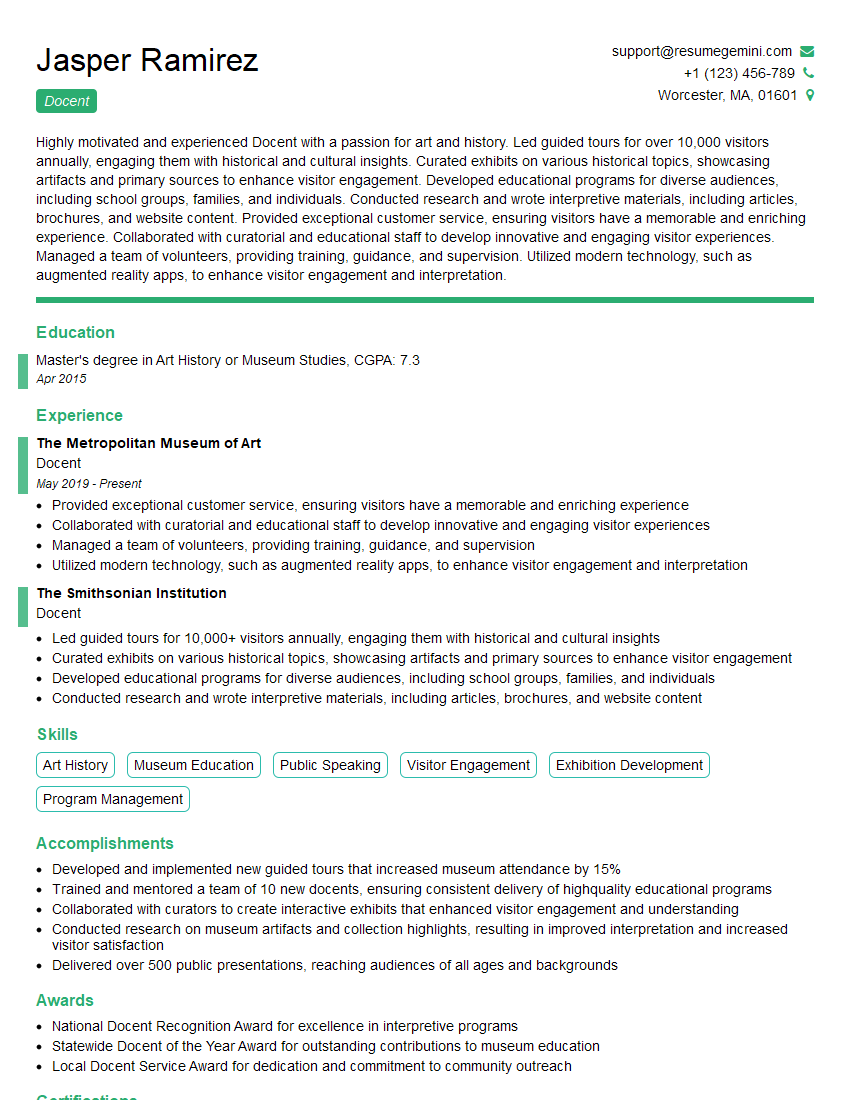Are you a seasoned Docent seeking a new career path? Discover our professionally built Docent Resume Template. This time-saving tool provides a solid foundation for your job search. Simply click “Edit Resume” to customize it with your unique experiences and achievements. Customize fonts and colors to match your personal style and increase your chances of landing your dream job. Explore more Resume Templates for additional options.

Jasper Ramirez
Docent
Summary
Highly motivated and experienced Docent with a passion for art and history. Led guided tours for over 10,000 visitors annually, engaging them with historical and cultural insights. Curated exhibits on various historical topics, showcasing artifacts and primary sources to enhance visitor engagement. Developed educational programs for diverse audiences, including school groups, families, and individuals. Conducted research and wrote interpretive materials, including articles, brochures, and website content. Provided exceptional customer service, ensuring visitors have a memorable and enriching experience. Collaborated with curatorial and educational staff to develop innovative and engaging visitor experiences. Managed a team of volunteers, providing training, guidance, and supervision. Utilized modern technology, such as augmented reality apps, to enhance visitor engagement and interpretation.
Education
Master’s degree in Art History or Museum Studies
April 2015
Skills
- Art History
- Museum Education
- Public Speaking
- Visitor Engagement
- Exhibition Development
- Program Management
Work Experience
Docent
- Provided exceptional customer service, ensuring visitors have a memorable and enriching experience
- Collaborated with curatorial and educational staff to develop innovative and engaging visitor experiences
- Managed a team of volunteers, providing training, guidance, and supervision
- Utilized modern technology, such as augmented reality apps, to enhance visitor engagement and interpretation
Docent
- Led guided tours for 10,000+ visitors annually, engaging them with historical and cultural insights
- Curated exhibits on various historical topics, showcasing artifacts and primary sources to enhance visitor engagement
- Developed educational programs for diverse audiences, including school groups, families, and individuals
- Conducted research and wrote interpretive materials, including articles, brochures, and website content
Accomplishments
- Developed and implemented new guided tours that increased museum attendance by 15%
- Trained and mentored a team of 10 new docents, ensuring consistent delivery of highquality educational programs
- Collaborated with curators to create interactive exhibits that enhanced visitor engagement and understanding
- Conducted research on museum artifacts and collection highlights, resulting in improved interpretation and increased visitor satisfaction
- Delivered over 500 public presentations, reaching audiences of all ages and backgrounds
Awards
- National Docent Recognition Award for excellence in interpretive programs
- Statewide Docent of the Year Award for outstanding contributions to museum education
- Local Docent Service Award for dedication and commitment to community outreach
Certificates
- Certified Museum Educator (CME)
- Certified Interpretive Guide (CIG)
- Museum Studies Certificate
- Gallery Management Certificate
Career Expert Tips:
- Select the ideal resume template to showcase your professional experience effectively.
- Master the art of resume writing to highlight your unique qualifications and achievements.
- Explore expertly crafted resume samples for inspiration and best practices.
- Build your best resume for free this new year with ResumeGemini. Enjoy exclusive discounts on ATS optimized resume templates.
How To Write Resume For Docent
- Highlight your passion for art and history, and your ability to engage visitors with your knowledge and enthusiasm.
- Showcase your experience in leading guided tours, curating exhibits, and developing educational programs.
- Demonstrate your customer service skills and your ability to create a welcoming and enriching experience for visitors.
- Emphasize your research skills and your ability to write clear and engaging interpretive materials.
- Mention your experience in using technology to enhance visitor engagement and interpretation.
Essential Experience Highlights for a Strong Docent Resume
- Lead guided tours for visitors, providing historical and cultural insights.
- Curator exhibits on various historical topics, showcasing artifacts and primary sources.
- Develop educational programs for diverse audiences, including school groups, families, and individuals.
- Conduct research and write interpretive materials, including articles, brochures, and website content.
- Provide exceptional customer service, ensuring visitors have a memorable and enriching experience.
- Collaborate with curatorial and educational staff to develop innovative and engaging visitor experiences.
- Manage a team of volunteers, providing training, guidance, and supervision.
Frequently Asked Questions (FAQ’s) For Docent
What are the key responsibilities of a Docent?
The key responsibilities of a Docent include leading guided tours, curating exhibits, developing educational programs, conducting research, writing interpretive materials, providing customer service, and collaborating with curatorial and educational staff.
What are the qualifications for becoming a Docent?
The qualifications for becoming a Docent typically include a Master’s degree in Art History or Museum Studies, as well as experience in leading guided tours and developing educational programs.
What are the benefits of becoming a Docent?
The benefits of becoming a Docent include the opportunity to share your passion for art and history with others, to learn from experts in the field, and to make a difference in your community.
How can I become a Docent?
To become a Docent, you can apply to a museum or historical organization that offers a Docent program. You will typically need to have a Master’s degree in Art History or Museum Studies, as well as experience in leading guided tours and developing educational programs.
What are the different types of Docent programs?
There are many different types of Docent programs, including those that focus on art, history, science, and culture. Some Docent programs are designed for adults, while others are designed for children.
How much do Docents earn?
The salary of a Docent can vary depending on the institution where they work and their level of experience. The average salary for a Docent is around $25,000 per year.
What are the career prospects for Docents?
The career prospects for Docents are good. Many Docents go on to become museum educators, curators, or directors.